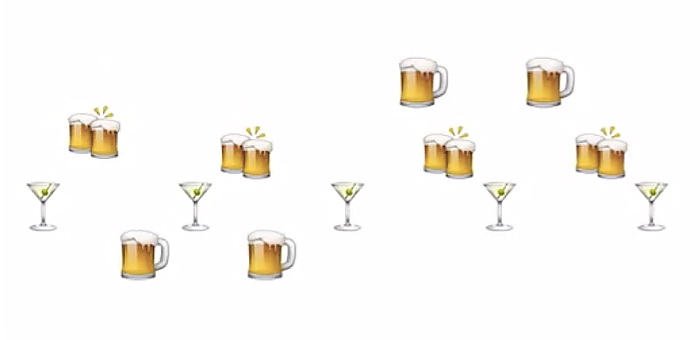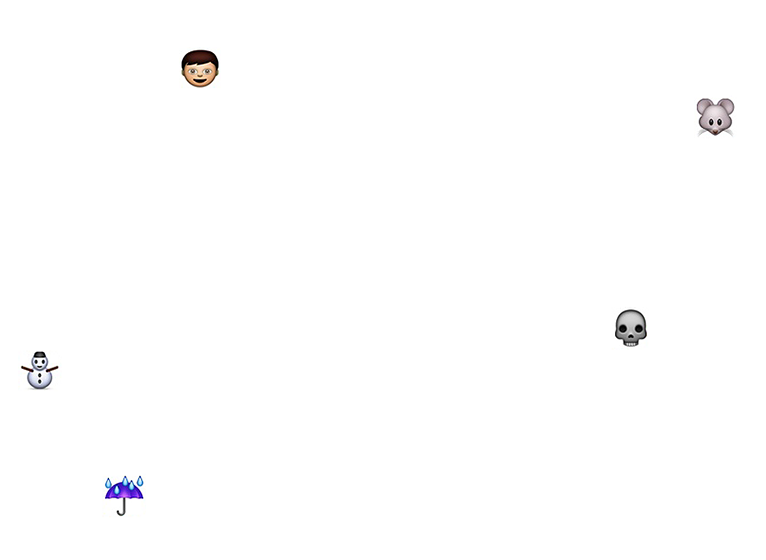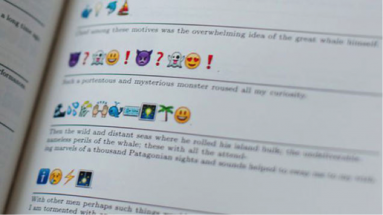Emoji offer you new possibilities for digital expression, but only if you’re speaking their language
If you smile through your fear and sorrow
Smile and maybe tomorrow
You'll see the sun come shining through for you
—Nat King Cole, "Smile"
The world will soon have its first emoji-only social network: Emoj.li. This news, announced in late June, was met with a combination of scorn and amusement from the tech press. It was seen as another entry in the gimmick-social-network category, to be filed alongside Yo. Yet emoji have a rich and complex history behind the campy shtick: From the rise of the smiley in the second half of the 20th century, emoji emerged out of corporate strategies, copyright claims, and standards disputes to become a ubiquitous digital shorthand. And in their own, highly compressed lexicon, emoji are trying to tell us something about the nature of feelings, of labor, and the new horizons of capitalism. They are the signs of our times.
Innocuous and omnipresent, emoji are the social lubricant smoothing the rough edges of our digital lives: They underscore tone, introduce humor, and give us a quick way to bring personality into otherwise monochrome spaces. All this computerized work is, according to Michael Hardt, one face of what he terms immaterial labor, or “labor that produces an immaterial good, such as a service, knowledge, or communication.” “We increasingly think like computers,” he writes, but “the other face of immaterial labor is the affective labor of human conduct and interaction” — all those fast-food greetings, the casual banter with the Uber driver, the flight attendant’s smile, the nurse patting your arm as the needle goes in. Affective labor is another term for what sociologist Arlie Russell Hochschild calls “emotional labor,” the commercialization of feelings that smooth our social interactions on a daily basis. What if we could integrate our understand of these two faces of immaterial labor through the image of yet another face?
Emoji as Historical Artifacts
The smiley face is now so endemic to American culture that it’s easy to forget it is an invented artifact. The 1963 merger of the State Mutual Life Assurance Company of Worcester, Mass., and Ohio’s Guarantee Mutual Company would be unremembered were it not for one thing: :), or something very much like it. An advertising man named Harvey Ball doodled a smiling yellow face at the behest of State Mutual’s management, who were in need of an internal PR campaign to improve morale after the turmoil and job losses prompted by the merger. The higher-ups loved it. “The power of a smile is unlimited,” proclaimed The Mutualite, the company’s internal magazine, “a smile is contagious…vital to business associations and to society.” Employees were encouraged to smile while talking to clients on the phone and filling out insurance forms. Ball was paid $240 for the campaign, including $45 for the rights to his smiley-face image.
Gradually, the smiley became a pop-culture icon, distributed on buttons and T-shirts, beloved of acid-house record producers. Its first recognized digital instantiation came via Carnegie Mellon’s Scott E. Fahlman, who typed :-) on a university bulletin board in 1982 in the midst of talking about something else entirely.
Nabokov, Fahlman remembered, had called for such a symbol in an interview with the New York Times back in 1969:
Q: How do you rank yourself among writers (living) and of the immediate past?
Nabokov: I often think there should exist a special typographical sign for a smile — some sort of concave mark, a supine round bracket, which I would now like to trace in reply to your question.
But it took 15 years after Fahlman’s innovation for emoji to appear — and they went big in Japan. Shigetaka Kurita, a designer for Japanese telecom carrier NTT Docomo, was instructed to create contextual icons for the company as a way to define its brand and secure customer loyalty. He devised a character set intended to bring new emotional clarity to text messages. Without emoji, Kurita observed, “you don’t know what’s in the writer’s head.” When Apple introduced the iPhone to Japan in 2008, users demanded a way to use emoji on the new platform. So emoji were incorporated into Unicode, the computer industry’s standard for characters administered by the Unicode Consortium. At that moment, emoji became interoperable on devices around the world, and Ball’s smiley face had been reified at the level of code.
Emoji as Technics
By some accounts, there are now more than 880 extent emoji that have been accepted by the Consortium and consolidated in Unicode. Control over emoji has become highly centralized, yet they make up a language with considerable creative potential.
With only 144 pixels each, emoji must compress a face or object into the most schematic configuration possible. Emoji, like other skeuomorphs — linoleum that looks like wood grain, the trash bin on your desktop, the shutter click sound on a digital camera — are what anthropologist Nicholas Gessler calls “material metaphors” that “help us map the new onto an existing cognitive structure.” That skeumorphism allows for particular types of inventiveness and irony. So the emoji![]() might act as a pictogram (“I stepped in a pile of
might act as a pictogram (“I stepped in a pile of![]() , an ideogram (“that movie was
, an ideogram (“that movie was ![]() , an emoticon (“I feel
, an emoticon (“I feel ![]() , or a phatic expression (“I’m tired.” “
, or a phatic expression (“I’m tired.” “![]() ”). That’s some powerful contextual
”). That’s some powerful contextual ![]() .
.
Yet this flexibility has a broader business purpose, one that goes hand-in-hand with the symbols’ commercial roots: emoji have been proprietary whenever it was possible for companies to do so. NTT Docomo was unable to secure copyright on its original character set, and competitors J-Phone and DDI Cellular Group soon produced rival emoji character sets, which were made available exclusively on their competing software platforms. Emoji were a practical and experiential icon of brand difference; their daily use drove the uptake of a particular platform, and by extension helped establish particular technical standards across the industry. But the popularity of emoji meant they were hard to contain: user complaints about the illegibility of a competitor’s emoji on their phones meant the telcos had to give up on making money off emoji directly. It was the necessity born of linguistic practice over time that prompted these grudging steps towards a technical and business consensus.
Hardt argues that affect is perennially more powerful than the forces attempting to harness it, and it would be tempting to think of emoji in this context. But emoji remain a restricted, top-down language, controlled by the Unicode Consortium and the technical platforms that display them. Media theorist Laura Marks uses the term lame infinity to describe the phenomenon where digital technology seems infinite but is used to produce a dispiriting kind of sameness. Emoji, as “a perfectly normcore system of emotion: a taxonomy of feeling in a grid menu of ideograms" fit that description. While emoji offer creative expression within their own terms, they also may confine us to a type of communicative monoculture. What’s more, emoji also hold out the promise of emotional standardization in the service of data analysis: If a feeling can be summed up in a symbol, then theoretically that feeling can be more easily tracked, categorized, and counted.
Emoji as Data Culture
We love emoji, and emoji depict our love, while also transforming our states of feeling into new forms of big data. Many platforms and media companies are extracting and analyzing emoji as a new source of insight into their customers’ emotions and desires. In the spring of 2013, Facebook introduced the ability to choose from a variety of emoji-like moods as part of a status update. Users can register that they feel happy, sad, frustrated, or a variety of other emotions. And with the recent uproar over the Facebook emotional-contagion study, it’s increasingly clear that quantifying, tracking and manipulating emotion is an important part of the company’s business model. “By selecting your current activity instead of merely writing it out, you structure data for Facebook,” TechCrunch observed when the feature was rolled out. And sentiment-analysis firms like Lexalytics are working to incorporate emoji into their business models.
In many ways, emoji offer us a deeply restricted world. This character set is valorized for its creative uses — such as Emoji Dick, Fred Benenson’s crowdsourced, book-length rewriting of Melville’s Moby Dick as emoji, which was accepted into the Library of Congress. But it is also constrained at the level of social and political possibility. Emoji are terrible at depicting diversity: on Apple’s iOS platform, for example, there are many white faces, but only two seem Asian and none are black. Responding to public outcry, Apple now says it is “working closely with the Unicode Consortium in an effort to update the standard.”
Emoji raise the question: What habits of daily life do emoji promote, from the painted nails to the martini glasses? What behavior do they normalize? By giving us a visual vocabulary of the digital everyday, emoji offer an example of what Foucault termed “anatamo-politics”: the process by which “the production of collective subjectivities, sociality, and society itself” is worked through at the level of individual practices and habits. And in a broad sense, what emoji are trying to sell us, if not happiness, is a kind of quiescence. In Katy Perry’s “Roar” video from 2013, for example, we see emoji transliterations of the song’s lyrics. But is also an eerily stark commentary on the basic anatamo-political maintenance of daily life – sleeping, eating, bathing, grooming, charging our devices. The habitual maintenance depicted in the video goes hand in hand with the “basic” emoji character set.

In a similar vein, the unofficial music video for Beyoncé’s “Drunk in Love” has brilliant, quick-fire emoji translation using characters from Apple’s proprietary font in front of a plain white background. The genius of the emoji “Drunk in Love” lies in how it perfectly conjures Beyoncé’s celebrity persona, and the song’s sexualized glamour, out of the emoji character set. Emoji can represent cocktails, paparazzo attacks, and other trappings of Western consumer and celebrity culture with ease. More complicated matters? There’s no emoji for that.
Emoji as Soft Control
“This face is a symbol of capitalism,” declared Murray Spain to the BBC. Spain was one of the entrepreneurs who, in the early 1970s, placed a copyright on the smiley face with the phrase “Have a nice day.” “Our intent was a capitalistic intent...our only desire was to make a buck.” The historical line connecting the smiley face to emoji is crooked but revealing, featuring as it does this same sentiment repeated again and again: the road to the bottom line runs through the instrumentalization and commodification of emotion.
Now with many Silicon Valley technology corporations adding Chief Happiness Officers, the impulse to obey the smiley has become supercharged. Emoji, like the original smiley, can be a form of “cruel optimism,” which affect theorist Lauren Berlant defines as “when the object/scene that ignites a sense of possibility actually makes it impossible to attain.” Emoji help us cope emotionally with the technological platforms and economic systems operating far outside of our control, but their creative potential is ultimately closed off. They are controlled from the top down, from the standards bodies to the hard-coded limits on what your phone will read.
Emoji offer us a means of communicating that we didn’t have before: they humanize the platforms we inhabit. As such, they are a rear-guard action to enable sociality in digital networks, yet are also agents in turning emotions into economic value. As a blip in the continuing evolution of platform languages, emoji may be remembered as ultimately conservative: digital companions whose bright colors and white faces had nothing much to say about our political impasses.
Luke Stark studies emotion and digital media. He is a doctoral student in the Department of Media, Culture, and Communication at NYU, and an intern at Microsoft Research. Kate Crawford researches the politics and ethics of data. She is a Principal Researcher at Microsoft Research, a Visiting Professor at MIT’s Center for Civic Media and a Senior Fellow at NYU’s Information Law Institute.


